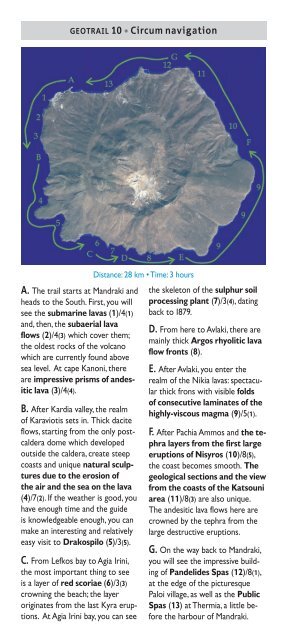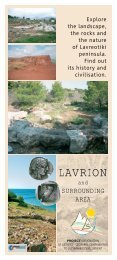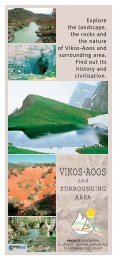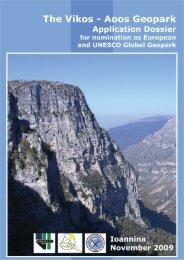NISYROS - Welcome to the Greek Geological Institute Web page ...
NISYROS - Welcome to the Greek Geological Institute Web page ...
NISYROS - Welcome to the Greek Geological Institute Web page ...
Create successful ePaper yourself
Turn your PDF publications into a flip-book with our unique Google optimized e-Paper software.
GEOTRAIL 10 Circum navigation<br />
A. The trail starts at Mandraki and<br />
heads <strong>to</strong> <strong>the</strong> South. First, you will<br />
see <strong>the</strong> submarine lavas (1)/4(1)<br />
and, <strong>the</strong>n, <strong>the</strong> subaerial lava<br />
flows (2)/4(3) which cover <strong>the</strong>m;<br />
<strong>the</strong> oldest rocks of <strong>the</strong> volcano<br />
which are currently found above<br />
sea level. At cape Kanoni, <strong>the</strong>re<br />
are impressive prisms of andesitic<br />
lava (3)/4(4).<br />
B. After Kardia valley, <strong>the</strong> realm<br />
of Karaviotis sets in. Thick dacite<br />
flows, starting from <strong>the</strong> only postcaldera<br />
dome which developed<br />
outside <strong>the</strong> caldera, create steep<br />
coasts and unique natural sculptures<br />
due <strong>to</strong> <strong>the</strong> erosion of<br />
<strong>the</strong> air and <strong>the</strong> sea on <strong>the</strong> lava<br />
(4)/7(2). If <strong>the</strong> wea<strong>the</strong>r is good, you<br />
have enough time and <strong>the</strong> guide<br />
is knowledgeable enough, you can<br />
make an interesting and relatively<br />
easy visit <strong>to</strong> Drakospilo (5)/3(5).<br />
C. From Lefkos bay <strong>to</strong> Agia Irini,<br />
<strong>the</strong> most important thing <strong>to</strong> see<br />
is a layer of red scoriae (6)/3(3)<br />
crowning <strong>the</strong> beach; <strong>the</strong> layer<br />
originates from <strong>the</strong> last Kyra eruptions.<br />
At Agia Irini bay, you can see<br />
Distance: 28 km • Time: 3 hours<br />
<strong>the</strong> skele<strong>to</strong>n of <strong>the</strong> sulphur soil<br />
processing plant (7)/3(4), dating<br />
back <strong>to</strong> 1879.<br />
D. From here <strong>to</strong> Avlaki, <strong>the</strong>re are<br />
mainly thick Argos rhyolitic lava<br />
flow fronts (8).<br />
E. After Avlaki, you enter <strong>the</strong><br />
realm of <strong>the</strong> Nikia lavas: spectacular<br />
thick frons with visible folds<br />
of consecutive laminates of <strong>the</strong><br />
highly-viscous magma (9)/5(1).<br />
F. After Pachia Ammos and <strong>the</strong> tephra<br />
layers from <strong>the</strong> first large<br />
eruptions of Nisyros (10)/8(5),<br />
<strong>the</strong> coast becomes smooth. The<br />
geological sections and <strong>the</strong> view<br />
from <strong>the</strong> coasts of <strong>the</strong> Katsouni<br />
area (11)/8(3) are also unique.<br />
The andesitic lava flows here are<br />
crowned by <strong>the</strong> tephra from <strong>the</strong><br />
large destructive eruptions.<br />
G. On <strong>the</strong> way back <strong>to</strong> Mandraki,<br />
you will see <strong>the</strong> impressive building<br />
of Pandelides Spas (12)/8(1),<br />
at <strong>the</strong> edge of <strong>the</strong> picturesque<br />
Paloi village, as well as <strong>the</strong> Public<br />
Spas (13) at Thermia, a little before<br />
<strong>the</strong> harbour of Mandraki.






